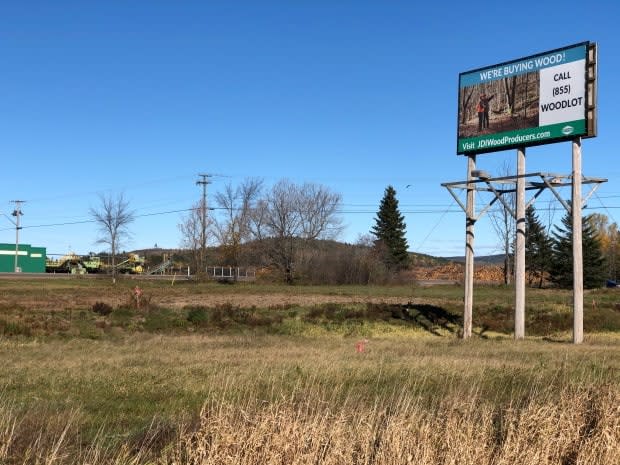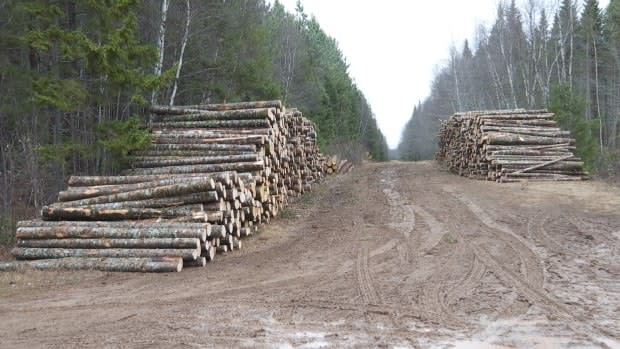Woodlot owners say N.B. pricing system keeps them from cashing in on high lumber demand
About 7,000 vehicles a day pass the billboard on New Brunswick Route 1 at Sussex.
'We're buying wood!', it announces, with a link to the J.D. Irving Ltd. website and a phone number: 855-WOODLOT.
In the background stands the JDI sawmill, with long rows of stacked logs.
Dialling that number is one of a handful of ways woodlot owners can get their timber to the province's biggest buyer.
If you sign a contract with the company, you can collect $64.25 a metric tonne for spruce studwood logs used to make two-by-fours.
It's a rate that is maddeningly low for those woodlot owners who are selling logs. And it hasn't budged despite booming lumber sales in North America this year.
These private wood sellers see the price as a symptom of a broken system, where some are quietly paid more for their logs, and an abundance of trees available to mills from Crown land prevents the majority from cashing in when times are good.

About 40 minutes to the west of Sussex, at his family farm in Shannon, one of those private growers, Bruce Colpitts, recalls some wisdom shared 20 years ago by his wife's grandfather, Lawrence McCrea.
"He said, 'Look after the land and the land will look after you,'" said Colpitts. "Well, 20 years ago the price of studwood was about $80 a tonne. Today that exact same product purchased here is $65 a tonne.
"And I guarantee you our costs have not gone down."
Across the provincial border, Nova Scotia woodlot owners are collecting $75 to $93 a tonne for the same wood at the gates to their mills.
Not easy to sell in Nova Scotia
Those higher prices, triggered in part by a COVID-related jump in demand for lumber, aren't being realized by New Brunswick tree growers who don't see hauling the wood to Nova Scotia as an easy remedy.
Not only are there added travel costs to reach that province's mills, but U.S. tariffs on New Brunswick's lumber make it more difficult to process that wood.
Nova Scotia is exempt from U.S. lumber tariffs, a status New Brunswick also enjoyed until May 2017, when the U.S. concluded the rising share of Crown wood being consumed in this province was distorting the market, acting as an unfair subsidy to our mills.
A 20.8 per cent tariff was slapped on lumber originating in New Brunswick. JDI was targeted at a lower rate, 9.9 per cent.

So while the quality of Nova Scotia logs is no different than those of New Brunswick, they require a completely separate accounting system.
"They can't run it through the mill with the Nova Scotia wood," said Neil Silliker, general manager of the South East New Brunswick Forest Products Marketing Board, whose members, overwhelmingly family woodlot owners, have the best shot at capitalizing on higher prices across the provincial border. "They've got to clean all the New Brunswick sawdust, chips, lumber out of the mill in order to run Nova Scotia wood again."
As a result mills in that province have a preference for local logs, if they're available.
Cheaper New Brunswick wood has also held down prices at those Maine mills closest to our border, making the trip there less attractive to many sellers, according to the Carlton Victoria Forest Products Marketing Board in Florenceville.
Two-tier system
But groups representing the province's woodlot owners have long claimed the biggest reason prices are being held down at home is that the largest mill owners have access to similar trees in the grandest woodlot of all, the taxpayer-owned Crown forest.
The price paid by those companies for trees taken from Crown land are based on the private market, in other words, on how much woodlot owners can fetch for their trees.
The woodlot groups claim there's a two-tier system. On one side, low prices paid to private landowners keep Crown wood prices in check. On the other, harvesting contractors, who have established relationships with the mills are being paid premium prices for logs. And those premiums aren't being shared with the landowner and aren't being disclosed to the New Brunswick Forest Products Commission, the arm's-length panel overseeing the private wood market and keeping track of prices.
"There's a lot of things happening that no one is tracking," said Rick Doucett, president of the New Brunswick Federation of Woodlot Owners. And so it's very difficult to know for sure what's happening out there, and what's fair and not fair."

In her October report, Auditor General Kim Adair–MacPherson, said only 20 to 30 per cent of the approximately 200 larger harvesting contractors respond to surveys on stumpage prices sent to them by the Commission.
There is no enforcement, even though it is required by law.
Her report recommends the province enforce the rule, or find a new way to get a more complete picture of that part of the market.
She also noted the province doesn't have a written definition for what constitutes fair market value for Crown stumpage, and that the province hasn't adjusted Crown timber rates, as required annually by law, since 2015.
Even so, to the dismay of private woodlot owners, Adair–MacPherson concluded the system for tracking private wood sales to set Crown wood rates is 'statistically sound' and a significant improvement over methods used in the past.
At the commission, executive director Tim Fox said the study on private tree sales examines 18,000 transactions, 60 per cent of which are between contractors and woodlot owners providing an "accurate reflection" of the market overall.

He said it is up to woodlot owners to ensure they are getting a good price for their trees by educating themselves about the market, something the province's woodlot marketing boards should be helping with.
"There may be certain cases where there may be [harvesting contractors] receiving a premium from a mill and not sharing a proportion (or any) of that premium with the woodlot owner when they could," said Fox. "When, or if that is the case, those wood producers directly contribute to keeping average stumpage rates lower."
Representatives from the majority of the province's marketing boards disagree with Adair-MacPherson's conclusion that the stumpage study, for the most part, is working.
At the Carlton Victoria Forest Products Marketing Board, Chair Andrew Clark says the Auditor General's team wasn't given the right numbers.
Is the data right?
"There's an old saying about computers, you know, garbage in, garbage out," said Clark. "We dispute entirely the fact that they can establish or pay a royalty rate based on these, on this stumpage data."
Mike Holland, the New Brunswick minister of natural resources and energy says he has confidence in the private wood prices survey. But he is on record saying there's work to be done on the province's forest management system. He's beefed up funding to allow the Forest Products Commission to add more staff to expand and speed up data gathering.
That, he said, will make the system more transparent, reassuring both international trade partners and the province's private woodlot sector.
An organization representing the province's mills says New Brunswick's private wood market is secure and stable, featuring sales between 'willing buyers and willing sellers, free from high price volatility seen elsewhere.
In the meantime questions are being raised about the whereabouts of a Deloitte study commissioned by the province in 2018.
Its mandate was to examine the forest products market in New Brunswick and in other comparable markets, and do an analysis of the "process and methodology" used to determine Crown wood rates.
The woodlot groups contributed to the study and have requested, without success, to see the final report.
A spokesperson for the Department of Natural Resources and Energy said the report is being reviewed and will be released in early 2021.


